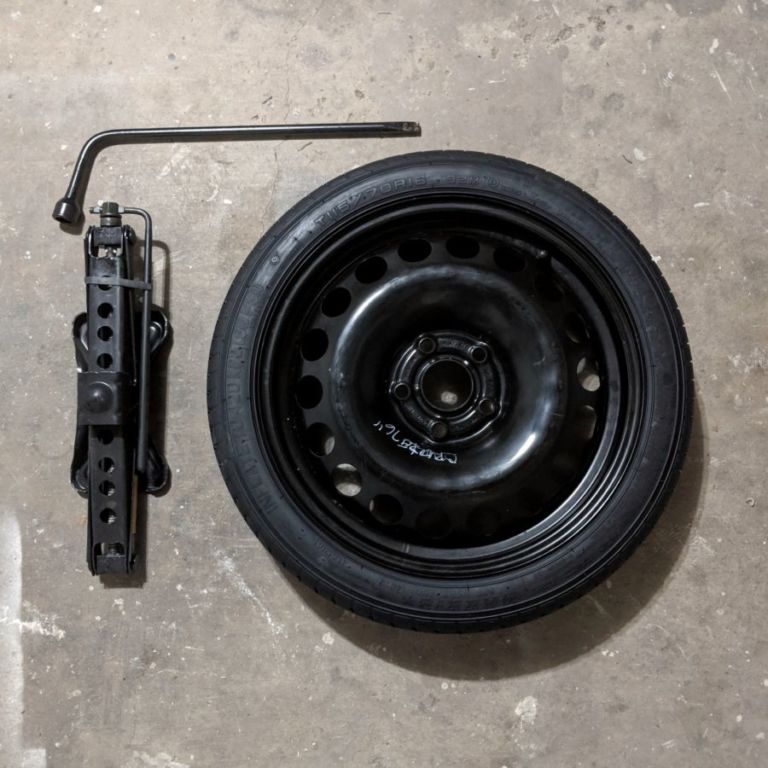If you have a flat tire, you know how frustrating a process it is to get your car back to its normal operation. Not only does it disrupt your travel, it also takes time and money to replace a flat. After you change the flat tire and install your spare, you might be wondering: how long can you drive on it?
In this article, we’ll tell you just how far you can drive on a spare tire, what the key differences in types of spare tires are, and best practices for driving on a spare tire.
Let’s jump right in by answering your main question:
You should drive no more than 50 miles on a temporary or donut spare tire if possible. If you absolutely must go longer than 50 miles, avoid driving on it longer than 70 miles. A spare tire isn’t meant to completely replace a tire, rather, its purpose is to tide you over until you can properly replace it.
Additionally, you shouldn’t drive faster than 50 mph on a temporary or donut spare tire, as they have far less traction and durability than a standard tire. You probably wouldn’t want to drive longer or faster on a spare anyway, as the typical spare can make your vehicle feel more like an airplane ambling down a runway than a car driving down a highway.
Once you are driving your spare, you should replace it with a proper full-size tire as quickly as possible to stay safe on the roads.
Types of Spare Tires:There are several kinds of spare tires, but which one you will use mostly depends on the type of vehicle you’re driving.
 These vehicles are significantly heavier than most sedans and mid-sized cars, so the spare tires are usually larger to support the vehicle’s full load, and possibly additional cargo or items being towed.
These vehicles are significantly heavier than most sedans and mid-sized cars, so the spare tires are usually larger to support the vehicle’s full load, and possibly additional cargo or items being towed.Full-size spares are typically much better quality than a donut spare; however, they still should be replaced as soon as possible. These spares often aren’t as durable, may have narrower wheels than the standard tires, and may not be produced by the same manufacturer as your other tires.
Full-size spare tires should be regularly inspected too, especially if they are secured to the bottom of the vehicle and therefore may be exposed to harsher elements.
How to drive safely on a spare tireRegardless of whether your spare is a donut or a full-size spare, you’ll want to be careful while driving on it. To drive safely on your spare tire, follow these best practices:
 Spare tires often have different inflation pressure needs than your regular tires, so it’s wise to check them for proper inflation. Plus, a spare tire isn’t much help if it has low pressure.
Spare tires often have different inflation pressure needs than your regular tires, so it’s wise to check them for proper inflation. Plus, a spare tire isn’t much help if it has low pressure. Many spare tires have a lifetime of about eight years.
Many spare tires have a lifetime of about eight years.As the Midwest’s premier driving school, Top Driver takes pride in preparing our students for everything they encounter on the road and with their vehicle.
With more than 40 locations throughout Illinois, Michigan, and Ohio, Top Driver is your best resource for driver education. Each year we provide countless hours of in-vehicle training and classes, not to mention our free blog covering best practices for road safety. If you’re looking for teen programs for new drivers, adult, or remedial courses, Top Driver has you covered.
We’re also going the extra mile to ensure a safe learning space for our students and instructors by providing remote classroom education opportunities and implementing a coronavirus vehicle sanitization process.
Call 1 (800) 374-8373 or enroll online today!
Editor’s Note: This blog has been updated in 2021 to reflect current industry standards.
In older cars, every model came with a spare tire that matched the tires already on the vehicle. Over the years, car manufacturers have realized the spare tire is used so infrequently, it does not make much sense to equip every car with a full-sized spare. For this reason, manufacturers began leaving a space-saver spare (otherwise known as a donut) in place of a full-size spare.
Nowadays, spare tires should never be a permanent replacement, begging the question, how long can you really drive on a spare tire? The type of spare tire in your vehicle makes a difference in how long and how far you can drive before fixing your tire or buying a new tire.
These narrow, compact spares are designed to save space and weight in the vehicle, allowing the manufacturers to build a smaller car. However, the tire itself is not built to last. Your owner’s manual will give recommendations for driving time and speed. A general rule of thumb is to drive no farther than 70 miles and no faster than 50 miles per hour before replacing your donut with a new tire.
The biggest reason why you should avoid prolonged use of space-saver or donut tires is that they have little to no tread, making the spare vulnerable to road hazards and projectiles. It is also much smaller than the other 3 tires, making it spin faster to keep up with the moving car.
Run-flat tires are becoming more common as manufacturers realize they cost less to maintain than traditional tires. If you drive a recent model BMW or a MINI, your car likely came with run-flat tires. These tires are tougher than most tires but are not designed to last forever, such as a full-spare tire.
Rather than including a spare tire, these run-flat tires are built to withstand most road hazards, including punctures. Rather than going flat or blowing out (as traditional tires do), a run-flat tire can continue to drive after punctured for about 50 miles before needing to be replaced. However, these tires cost more to replace than traditional tires.
While you have a bit more room to travel on these types of tires, it is important to inspect your tire as soon as you are aware of any change in tire pressure. This gives you an idea of how long you have until you have no choice but to have your tire replaced.
This gives you an idea of how long you have until you have no choice but to have your tire replaced.
How Long Can You Drive on a Full-Size Spare Tire?
For years, cars were built with spare tire wells capable of carrying a full-size spare. On many older cars (and a few newer models), this is still the case. If you bought a truck, SUV, or another large vehicle, your car probably is equipped with a full-size spare. While a full-size spare is heavier and requires a larger space for storage, these tires are more durable and can handle a drive similar to a regular tire.
Once you have taken your vehicle to an auto repair shop and learned that the punctured tire is irreparable, you can request the spare tire to be put on the original rim.It is important to note that a full-size spare tire is usually not produced by the same manufacturer as the rest of the tires on your vehicle, meaning it will handle differently than the other tires. We suggest buying a new tire as soon as you can afford to, but this can easily buy you some time.
Christian Brothers Automotive was born out of the idea of not just being an auto repair shop, but also a neighbor. Our mission is simple: to take root in the local communities we serve and to create an uncommonly great experience for customers in need of auto service and repair. To have your tires inspected or to replace a spare tire, please do not hesitate to call or visit your local Christian Brothers Automotive shop. We have 240 plus locations nationwide that are locally owned and operated, providing complete auto care and repair solutions near you.
Spare tires are useful insurance, but most are not designed to replace a flat tire indefinitely.
Not all spare wheels are created equal, and to better understand which spare tire your vehicle is equipped with, please refer to your vehicle owner's manual. Temporary spare tires generally do not have the life expectancy that regular tires do. Unlike a normal car tyre, spare tires can only have one polyester ply in the sidewall and two steel belts with a ply of polyester in the tread, meaning they can't provide half the performance and safety that an average tire can provide.
In this article we will try to describe all types of spare wheels available, and tell you how long you can drive on each of them.
These little spare tires are commonly referred to as donuts or space savers. They are very popular because they are lightweight and do not take up much space in the luggage compartment of your car. Due to the low weight, even a person who is not at all predisposed to physical activity will not find it difficult to lift and install such a spare wheel. By the way, how to do it in the field, without the help of specialists, read here.
However, because the donuts are smaller and lighter, they lack two key features of conventional tires: strength and stability. Most of these spare tires have a speed limit of up to 90 km/h. With such a spare tire, you can expect to cover a distance of 80 km, some of them can cover up to 110 km. This should be enough to find the nearest tire shop and fix the damaged tire, or find a store where you can buy a brand new tire if the previous one is no longer repairable.
From the above, we can conclude that the donut spare wheel is not recommended for long trips or pulling with its replacement with a normal, standard wheel.
Some car manufacturers fit their vehicles with full size spare tires. They are, of course, heavier than space savers and take up much more space in the trunk, but they are more durable and durable. They are able to last you much longer than donuts. However, these tires may have a different tread pattern or rubber compound than a conventional tire. This can affect overall handling and safety on the road.
Although these tires are more durable, they are primarily designed to get you to your destination before you deal with the tire problem. In addition, do not forget that the place for the spare wheel in the car is empty, and it should be filled as soon as possible before another tire is punctured.
If you do not have a spare tire in your vehicle, then your vehicle may be equipped with run-flat tires. BMW and MINI typically install these tires during production. This type of tire is tougher than other tires and can withstand a puncture and keep going. However, they are also not designed to be ridden forever.
BMW and MINI typically install these tires during production. This type of tire is tougher than other tires and can withstand a puncture and keep going. However, they are also not designed to be ridden forever.
Most run-flat tires recommend replacing as soon as you notice a puncture. As a rule, they are designed for a distance of up to 100 km in a punctured state, then they must be replaced. Compared to regular tyres, running-flat replacements are not cheap. Some craftsmen can patch run-flat tires, but manufacturers do not recommend going down this path.
One of the advantages of these tires is that you can get to the nearest car wheel shop at speeds up to 80 km/h, i.e. almost like a breeze.
Every motorist should remember that any type of spare tire is only there to keep you moving forward and replace a punctured tire as quickly as possible. The spares are a temporary replacement, and s, while full-size spare tires may look exactly like the rest of your car, they don't have the same performance as s and can get you in trouble on the road.
Remember, your car's tires are the only thing that keeps you and your passengers on the road, so you should never speculate on your own safety or the safety of those around you.
LADA
UAZ
Kia
Hyundai
Renault
Toyota
Volkswagen
Skoda
Nissan
GAS
BMW
Mercedes-Benz
Mitsubishi
Mazda
Ford
All brands
Many factors influence the answer. We took them into account and prepared a cheat sheet for all occasions.
Related materials
7 rubber signals: what the tire says about car problems
How do you know when tires are completely worn out and it's time to change them? Everything is simple. For summer tires, the limit is 1.6 mm of residual tread depth, and for winter (or all-season tires used in winter) - 4 mm. Modern summer tires can travel from 40,000 to 70,000 km, depending on driving style and vehicle characteristics. An average motorist rolls such a mileage on summer tires in 2-3 seasons. Moreover, wear implies not only a decrease in tread depth. For millions of cycles of deformation, the strength of the carcass and its adhesion to the layers of the rubber compound are violated. In short, every 2-3 years you should buy a new set of tires.
Modern summer tires can travel from 40,000 to 70,000 km, depending on driving style and vehicle characteristics. An average motorist rolls such a mileage on summer tires in 2-3 seasons. Moreover, wear implies not only a decrease in tread depth. For millions of cycles of deformation, the strength of the carcass and its adhesion to the layers of the rubber compound are violated. In short, every 2-3 years you should buy a new set of tires.
In the event of permanent damage to one of the tires and a relatively high total mileage of the kit, it is also worth considering replacing it. Well, or about buying at least a pair of new tires, which, for any type of drive, should be installed on the front axle. We put two tires back - the most decent of the remaining ones.
Many motorists drive only a few thousand kilometers a year. This does not mean that the tires will serve you for several decades. According to Russian requirements (GOST 4754–97), the service life of passenger car tires is 5 years from the date of manufacture. And for example, Continental recommends that all car tires (including the spare tire) older than 10 years old should be replaced with new ones. Therefore, with small runs, you can navigate for ten years. The date of manufacture of the tire is indicated on the sidewall. Usually it is an oval with four numbers. The first two are the ordinal number of the week in the year, the last two indicate the year.
And for example, Continental recommends that all car tires (including the spare tire) older than 10 years old should be replaced with new ones. Therefore, with small runs, you can navigate for ten years. The date of manufacture of the tire is indicated on the sidewall. Usually it is an oval with four numbers. The first two are the ordinal number of the week in the year, the last two indicate the year.
Related materials
How to change the car yourself - detailed instructions
Tires should be rotated periodically in accordance with the vehicle manufacturer's recommendations - information on this can be found in the owner's manual.
We can advise you to carefully use the tires and, most importantly, to store them correctly in the off-season. First of all, during storage, it is important to exclude direct sunlight from hitting the tires, which greatly age the rubber. Tires without rims should be placed vertically, and stacked on rims.
Tires without rims should be placed vertically, and stacked on rims.
And before installing tires on a car at the beginning of the season, evaluate their condition. There should be no cracks in the tread and sidewalls. The tire should not be dry, it should remain rubbery and not look like baked plastic.
Related materials
Driving on badly worn tires - will I be fined or not?
Winter tires have a much shorter life span. They almost always fail due to the wear of the treadmill, because the tread of a new tire is 7–8 mm, and only 3–4 mm remain working height. If the tires are studded, then with such wear there are very few metal elements left, and the tire will not provide adequate safety when driving on a winter road. However, not only spikes, but also Velcro, with such a degree of wear, also lose most of their capabilities.
The real life of winter tires rarely exceeds 30,000 km.